4 Strategic Content Ideas to Speed Up Enterprise SaaS Deals
Last updated: February 18th, 2025
There’s a tendency among B2B SaaS companies to switch off marketing to prospects once they’ve signed up for a demo. At this stage, it becomes the sales team’s responsibility to close them, and marketing continues to focus on getting more prospects into their pipeline.
But especially in enterprise SaaS with many different decision-makers involved, all with varying levels of awareness regarding the value of their products, the process of getting everyone’s buy-in is difficult and time-consuming.
During these long sales cycles, there is all this time and opportunity where they could use marketing to support and speed up the sales process, but they often don’t. And if they do continue marketing to those people, they’ll often deliver the same ads as before with one-size-fits-all messaging that does more harm than good (a problem we covered in our piece on remarketing strategy for SaaS).
So lately we’ve been thinking about specific things we could do to help support our clients’ sales organizations during longer sales cycles. Our approach is to say, what are the questions and objections that these prospects are likely to have throughout the sales process? And how can we deliver them content such that we:
- Assist in answering these questions and objections before and after demo calls
- Take some of the weight off of sales
- Speed up the sales cycle and ultimately close more leads
And the beauty is that sales teams already know the questions and objections likely to come up, so all you have to do is figure out what they are, and come up with (or repurpose) content that helps to answer them.
In this article we’ll share our approach to speeding up enterprise SaaS deals and outline specific content ideas we’ve been testing to achieve this goal.
Get your Free Marketing Plan today to learn more about how we help B2B SaaS companies grow through paid media and SEO. If you want to learn more about our approach, check out our Predictable Growth Methodology that’s the basis for what we do.
First, A Note on Sales and Marketing Working Together
Despite a lot of sentiment out there for sales and marketing teams to work together, the culture within many SaaS companies is still one of, “Hey, we’re sales, we’ll take care of our stuff. Your job is marketing, you send us leads and we’ll worry about closing them.”
But for enterprise SaaS deals that can range from $50k to $5 million per year in revenue, it makes absolutely no sense for sales to single-handedly be responsible for closing prospects during long sales cycles. And compared to the budget it takes to run prospecting campaigns, the size of your actual pipeline is so much smaller that the budget required to market to them is minor in comparison. So we think leveraging marketing beyond demo signups is a no brainer.
In fact, closer coordination between sales and marketing is essential for the content ideas that follow to have the desired effect.
How Content Repurposing Speeds Up Enterprise SaaS Buying Cycles
Converting an MQL into an SQL requires a level of trust and understanding of the value of your product.
To increase the rate in which you build trust and teach prospects about the value of your product, you need customers to have more touchpoints with your content over a shorter period of time.
The formula to achieve more touchpoints in a shorter time frame is increasing the volume of content that addresses specific pain points across the buyer journey.
Yet producing high quality content at scale is resource intensive, and many companies run out of content ideas.
So instead of creating new content, why not take an existing piece of content and just reformat it for different channels?
This allows you to maximize the reach of a single idea, and content repurposing is significantly less resource intensive than creating net new content.
Here’s an example of how we do this internally at Powered By Search.
1. LinkedIn Post
We recently created a graphic of the Google Ads blueprint we use internally and then repurposed it as a template on LinkedIn and sent a downloadable version to those who commented.
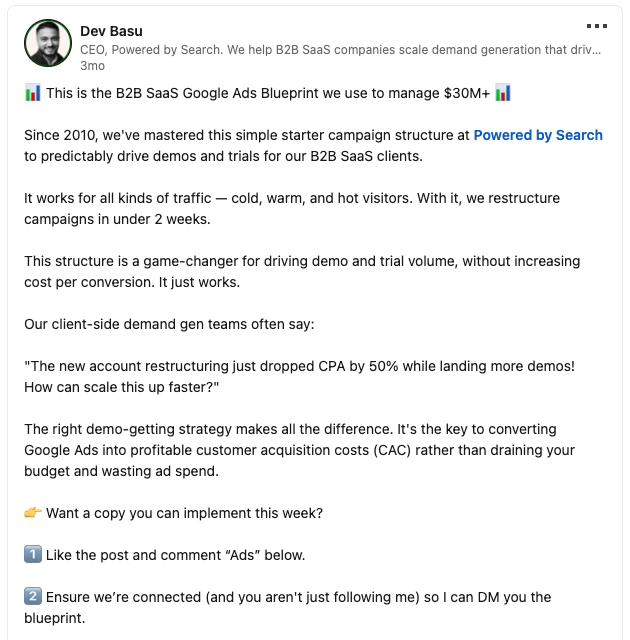
2. LinkedIn Live Event
From there, we also repurposed it into a LinkedIn live event (a webinar).
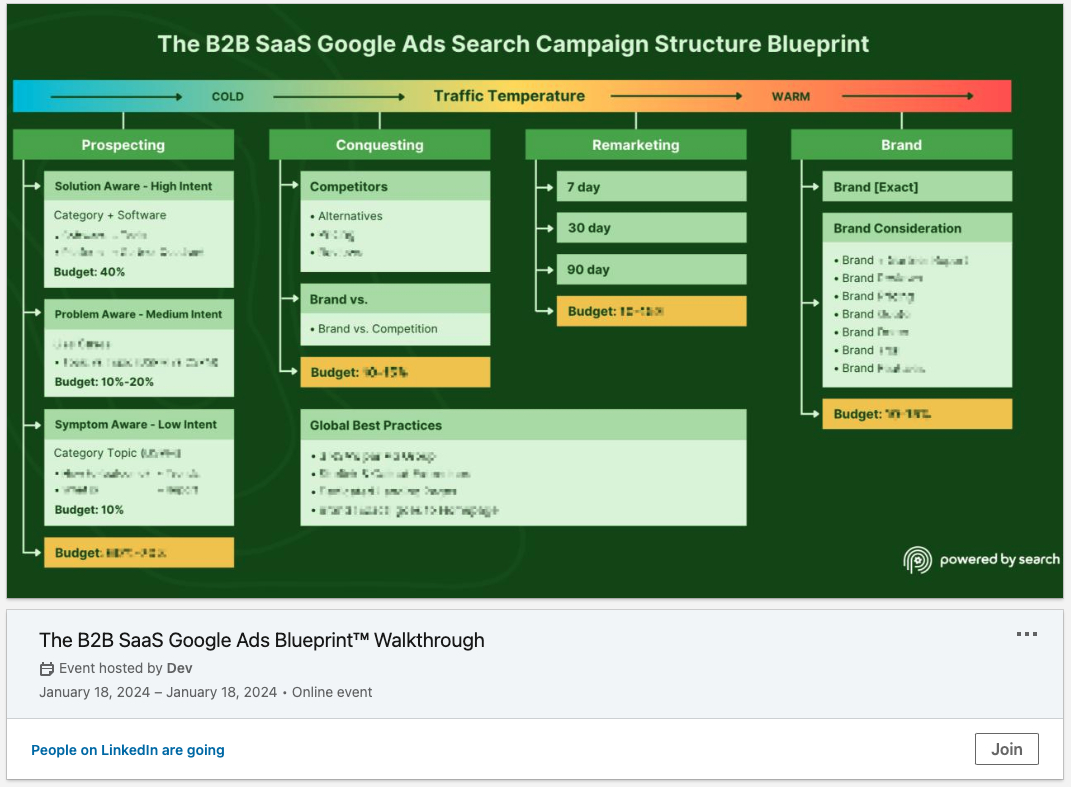
3. Blog Post
Next, we took the transcription from the webinar and transformed it into a blog post.
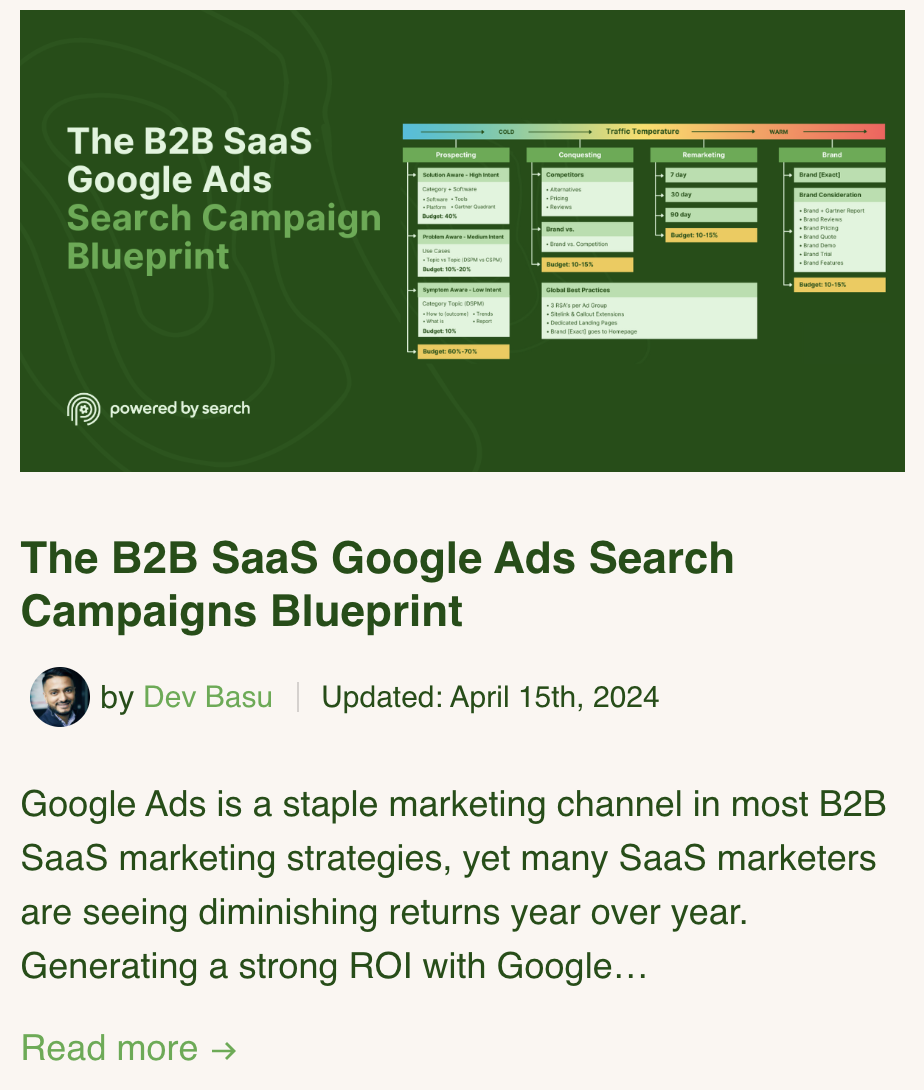
4. Email Newsletter
Finally, we’ll take the blog post and turn it into an email newsletter.
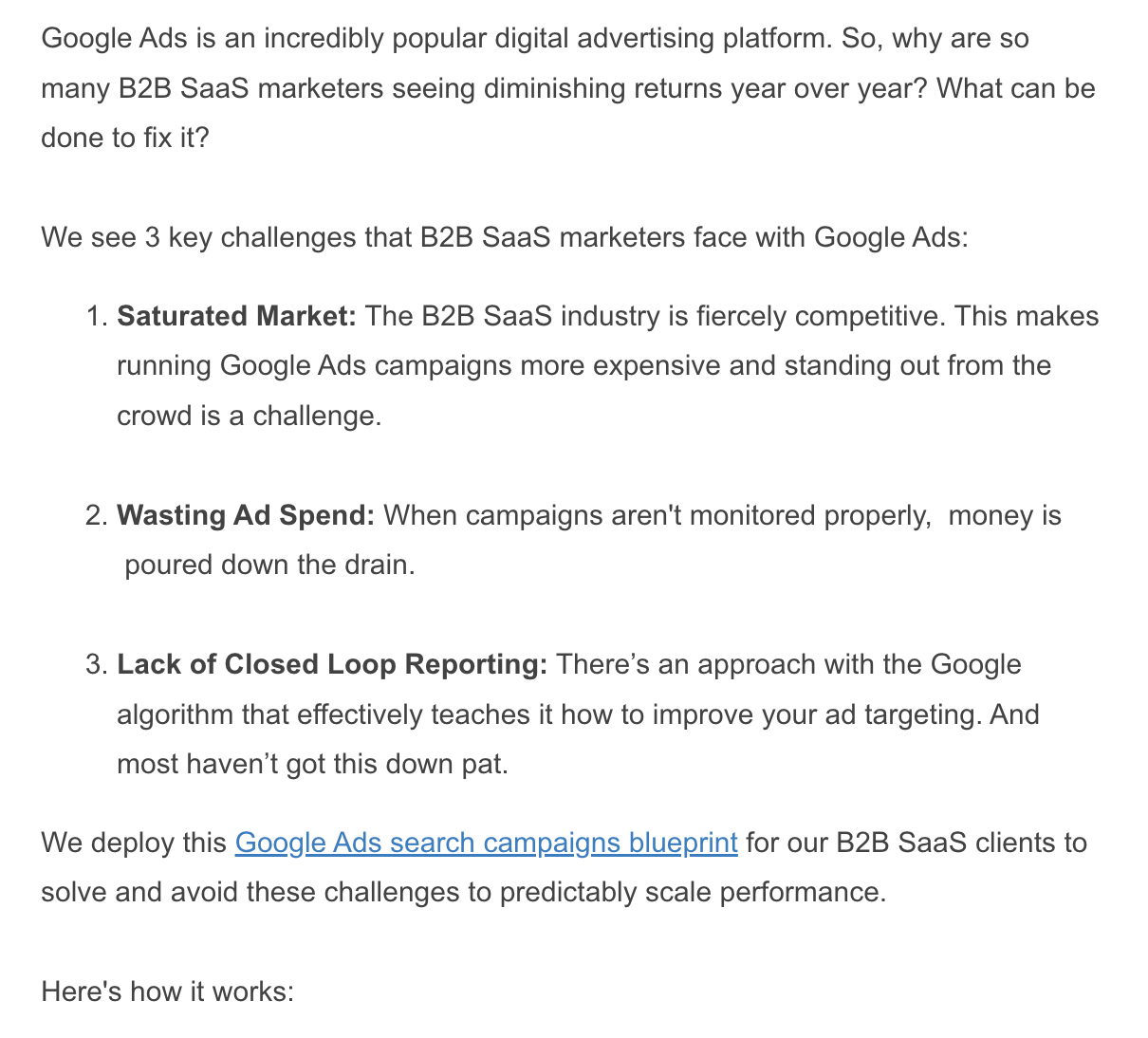
This strategy allows us to consistently publish a high volume of quality content, which accomplishes three goals:
- Reach new prospects: Not all prospects are active on the same marketing channels (i.e., Twitter, LinkedIn, etc.), so publishing across multiple channels allows you to reach new prospects.
- Re-engage prospects: Even if prospects have already seen your content on a different platform, seeing it again on another platform keeps your brand top of mind and increases the touchpoints with your brand, which ultimately speeds up the buying journey.
- Maintain a consistent brand narrative: Another benefit of repurposing a single piece of content into multiple formats rather than creating brand new content is that it ensures the narrative of your brand remains consistent. As a result, you won’t have to worry about confusing prospects with mixed messaging.
From a tactical standpoint, we recommend that you take a weekly piece of content, such as a video, and build a repurposing team to reformat it across various formats and channels. You could repurpose a single quarterly thought leadership piece of content into weekly and even daily content:
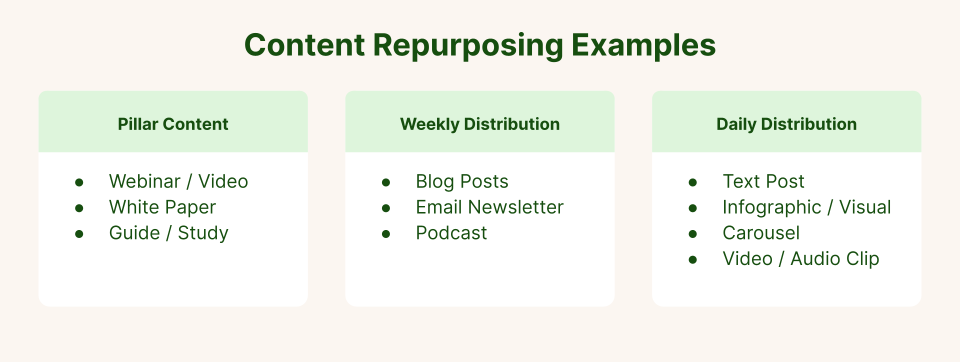
4 Content Repurposing Opportunities To Speed Up Enterprise SaaS Deals
The reality of an enterprise customer journey is that there are so many different touchpoints that prospects only ever see a fraction of the content you send them when they’re MQL’s. And very often, content made for MQL’s is created to do exactly what you want content for SQL’s to do — answer questions, handle objections, and aid the sales process. So the first thing you can do is repurpose this content.
For example, let’s say you have a 14-day email series that you send to MQL’s. In the emails, you include links to educational blog articles or customer success stories. Chances are the majority of hot prospects have only read a small portion of these by the time they become an SQL.
So to repurpose this content, you could create omnichannel remarketing ads and push them out to your SQL’s with the only objective being for them to consume the content.
Now that you know how to repurpose content, it’s essential to repurpose the right content. If you amplify content that is irrelevant to the buyer journey, it won’t help you attract or engage prospects and ultimately won’t drive conversions.
Here are four excellent content repurposing opportunities that are particularly effective at speeding up enterprise SaaS deals.
Note: If you want to be really smart about this, you can remove CTA’s from the content. For example, if you use HubSpot, you could use their smart CTA feature and set criteria that if the person visiting a page is an SQL, show it without the CTA. That way you’re not asking someone to sign up for a demo when they already have. We see very few SaaS companies approaching journey-offer fit at this nuanced level, and we think it’s undervalued.
1. Video Testimonial Remarketing Ads
This is a tactic we’ve recently started testing for our own agency. The idea came up when we heard the CEO of one of our clients (Jordan of CartHook) talk about us on a podcast.
He spent about 10 minutes giving us a solid tip of the hat, and we realized it would be a great testimonial to share with companies considering working with us. So we created an audiogram that we’ve been using in remarketing ads for SQL’s.
We used Headliner to create a simple visual to pair with the audio, and then we let his testimonial do the rest. So far we’ve had several prospects mention on calls that they saw the video and were intrigued by it. And this is a tactic we think would translate really well to marketing SaaS products to SQL’s — so we’ll likely try this with our clients too.
While you may not have access to a customer talking you up on a podcast, if you can find the right customer (or customers) to provide you with a genuine audio testimonial, this can be a really powerful tool.
2. Turn SaaS Battlecards Into Competitor Comparison Content
Many SaaS companies use “battlecards” as tools for salespeople to handle common objections that come up from prospects and to do so in a consistent way across their sales team.
But often the content of their battlecards never ends up being used as marketing collateral on their site. Some of the points made might be found in their competitor comparison landing pages (if they have them set up), but often there’s room for using battlecard content to improve those pages.
To demonstrate this, consider this common battlecard format:
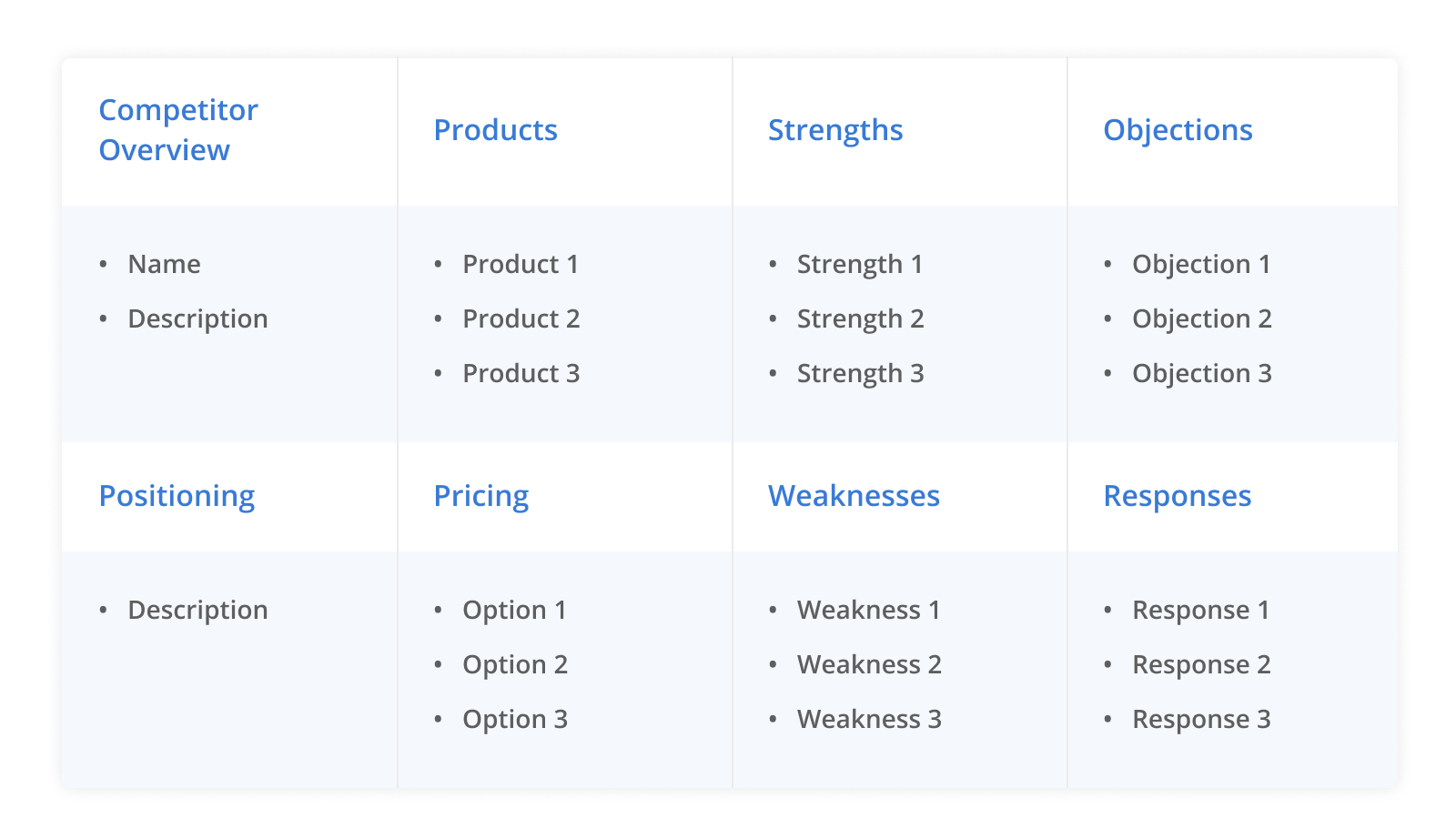
And let’s look at how it’s content could translate onto a competitor comparison page. Here’s a wireframe with the format we use when building these pages for our clients:
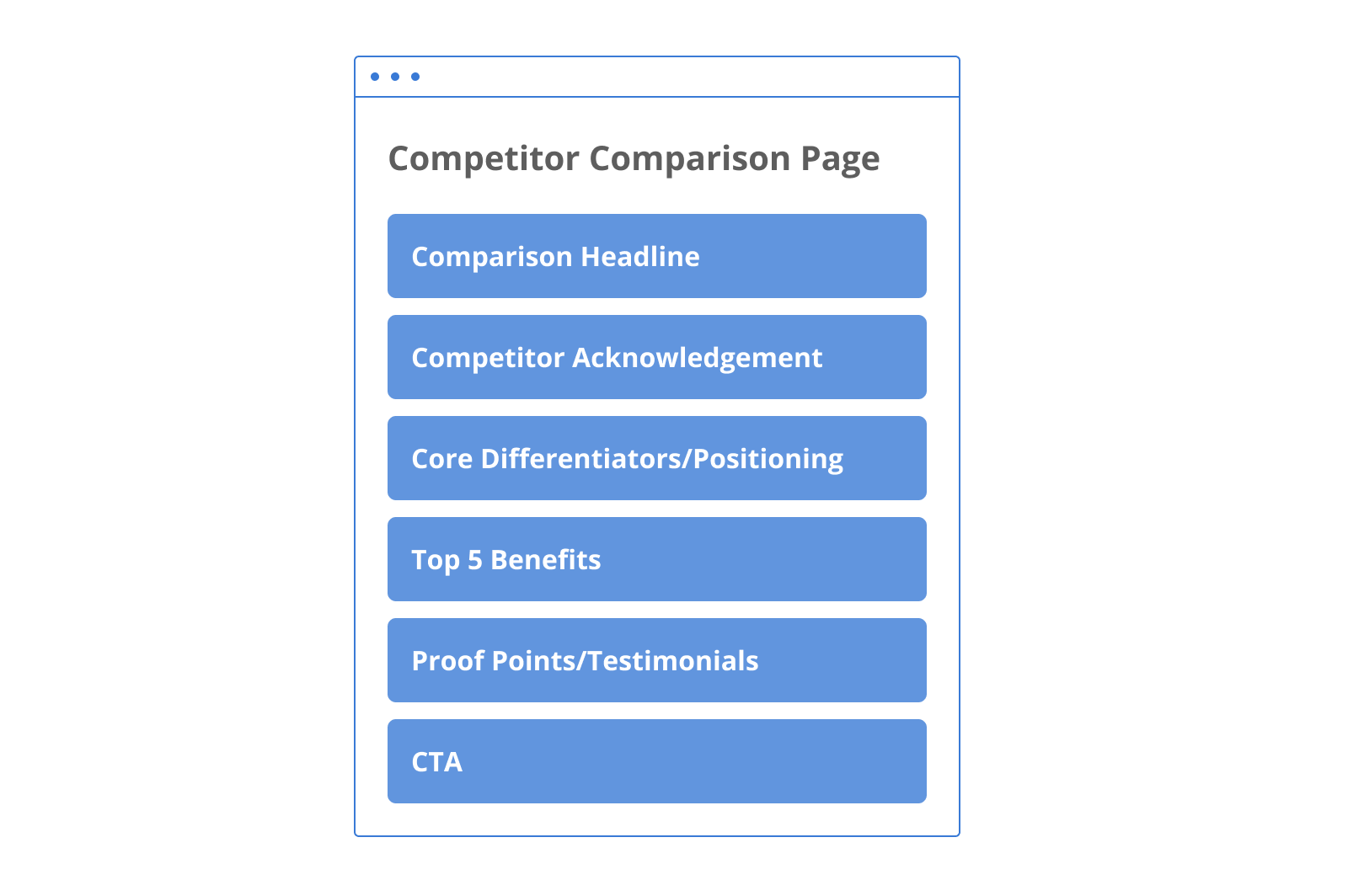
To translate the battlecard content onto your comparison page, you could:
- Use the battlecard positioning section to help frame your own core differentiators/positioning section
- Use the strengths section to help create your competitor acknowledgement section
- Use the objections and responses sections to inform the Top 5 Benefits you choose (ie. focus on benefits that handle common objections as they relate to your competitor)
- Use the weaknesses section when choosing testimonials (eg. you might use testimonials from customers who have switched from your competitors service to yours based on those weaknesses)
So whether you use your battlecards to create new comparison pages, or to beef up and strengthen existing ones, these pages can be utilized throughout long sales cycles to preemptively respond to prospects who are considering alternatives.
3. Use Compelling Snippets From Sales Conversations
Another idea we’ve been thinking about is the possibility of using snippets from real sales conversations that answer questions or objections that prospects have asked.
For example, if you use a tool like Chorus.ai for recording sales calls, you could take highlight moments and string them together into audio content (similar to the video testimonials above) for remarketing ads.
You’d need permission from prospects, so you’d probably want to pull from conversations where the prospects eventually became customers — ones you have a solid relationship with that you think would approve.
After a prospect schedules a demo, you can send them these resources to review before the call. As a result, prospects will show up with a better understanding of your product and ask more advanced questions, which speeds up the buying cycle and makes them more likely to take the next step at the end of the demo.
You can also analyze FAQs from sales conversations and create downloadable templates that solve these problems in a low-fi way, such as spreadsheets or checklists.
These resources give prospects a teaser of the value of your solution before they ever schedule a demo, which resolves objections and builds trust so that they’re ready to take the next step when they finally get on a demo.
Our precursor marketing resource discusses exactly how we create and promote these templates, as the type of template you create and how you market it significantly influences its impact on the buyer journey.
4. Use Snippets From Customer Success Onboarding Webinars
This idea reflects a core theory we have, something that’s a consistent theme in our Predictable Growth Methodology, which is that using marketing to show prospects what life would be like in the next stage of their journey with you is an effective way of guiding them to the next step in the process.
So for SQLs who are on the fence about signing up with you, share content with them from your onboarding webinars that illustrates how your product solves specific pain points. For many prospects, visually watching how a product solves the exact problem they’re facing is the most compelling pitch.
Additionally, this content already exists – you don’t have to create any net new content. So why not give prospects a taste of this to entice and nudge them to opt in?
For example, Datadog could pull snippets from their weekly live demos that show how their out of the box visualizations make it easy for new users to jump in and begin getting immediate value out of their platform.
You can also analyze FAQs from customer success onboarding webinars and create content that answers those questions.
For example, if you have a fundraising platform and customers frequently ask how to use it most effectively to boost email response rates, you could create a piece of content that illustrates how to use your content to boost email open rates.
Build An Effective Distribution Flywheel That Addresses The Full Buyer Journey
The ideas above illustrate specific ways SaaS companies can maximize the reach of high value content. Yet if your content only addresses one or two stages of the buying cycle, prospects will turn to your competitors to fill in the gaps of their buying journey.
The solution to keep prospects engaged is to review the buyer awareness matrix, which illustrates several different types of content for each stage of the buyer journey.
For each pillar piece of content you produce, think about how you can repurpose it into different formats for each of the four quadrants.
For example, ideas from a webinar could also be repurposed into a quiz, a use case page, and a scorecard.
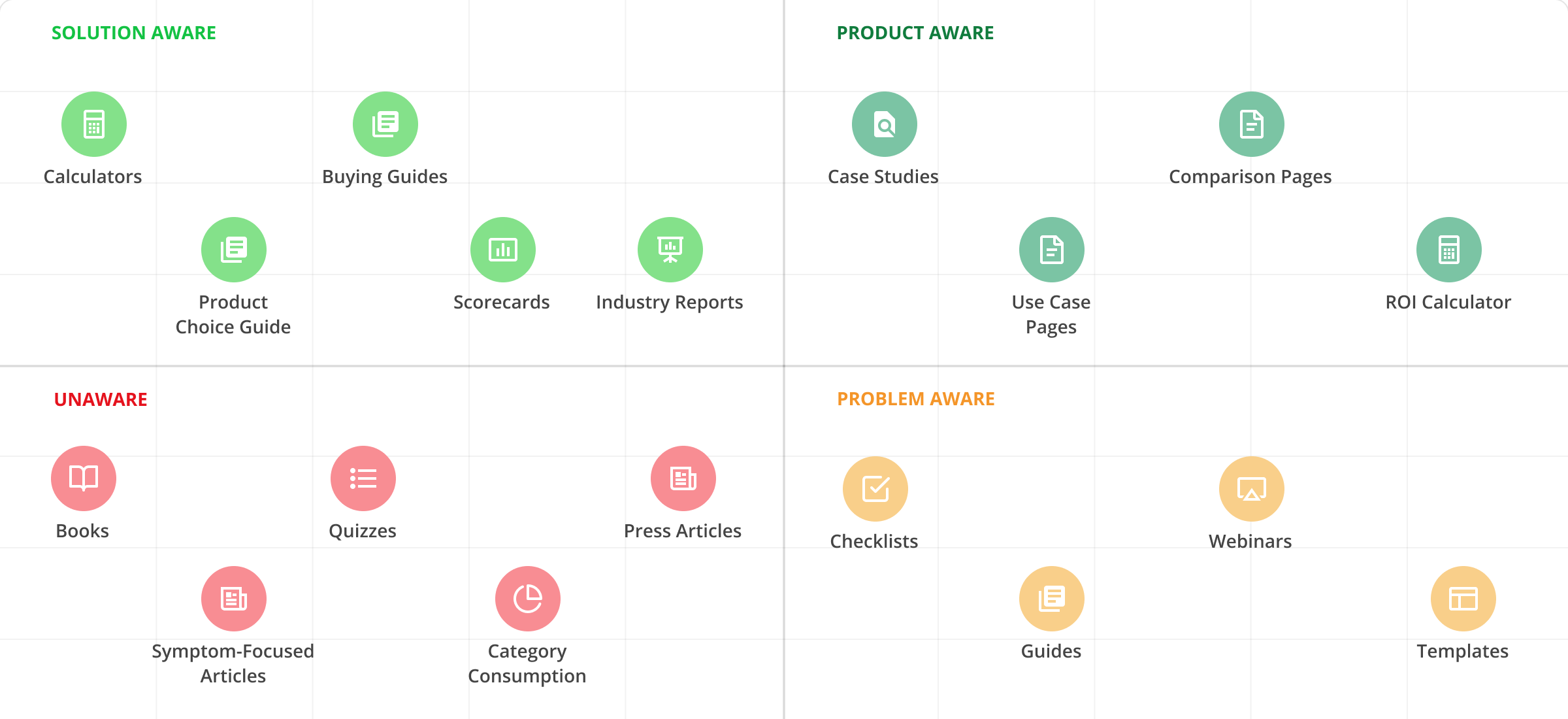
Once you have content for each of the four quadrants, it’s important to help prospects find it. If you don’t lead them to the next step in the buyer journey, they’ll likely leave your brand’s ecosystem to pursue their own path.
The simple solution to keep prospects engaged with your brand is to add a CTA at the end of each piece of content that gives them the next step. This is usually a lead magnet that captures their email address and allows us to introduce them to an email nurture sequence.
We find email is the most effective channel to re-engage and nurture prospects for a few reasons:
- Email is an owned marketing channel: Unlike social media channels and even SEO, you aren’t reliant on an algorithm to show your content to a group of prospects. Email allows you to ensure your content reaches each prospect.
- Email allows you to send the right content at the right time: Once someone opts into your email list, you can send them content appropriate for each stage of the buying journey so that you answer objections as they arise, making them more likely to convert faster and remain engaged with your brand rather than turning to a competitor for information.
As most enterprise B2B SaaS buying cycles last months, or even years, having a nurture sequence that allows you to consistently communicate with your prospects without relying on a third party platform is essential to closing a deal.
So what type of email nurture sequence should you send to prospects?
If your emails don’t provide value to prospects, they won’t open them, and you won’t see an ROI from your email marketing efforts.
We’ve tested a variety of email nurture formats, and we’ve found that the 14-21 day email nurture sequence is the most effective at engaging and converting enterprise B2B SaaS products.
While we have a separate blog post that outlines the exact email nurture template we use, here’s the main framework:
- The asset delivery
- 2-4 hot button emails
- The probing question
- The breakup
By nurturing prospects through email, you’ll increase the conversion rates of your content marketing efforts.
The combination of more conversions from each piece of content with increased content output will help you see a noticeable improvement in the ROI of your overall content marketing strategy.
Identify Additional Opportunities To Speed Up Enterprise SaaS Deals
These content repurposing frameworks are excellent templates to speed up your enterprise SaaS deals, but your results will vary depending on factors like the types of FAQs you select, the copywriting within your content, and other nuances.
These efforts can allow you to continue framing your offering to prospects in a compelling way throughout the sales cycle, and if executed well, will help you close more leads.
We’re excited to begin testing out some of these ideas with our own clients. If you end up using any of them, we’d love to hear how they work!
Get your Free Marketing Plan todayto learn more about how we help B2B SaaS companies grow through paid media and SEO.
What you should do now
Whenever you’re ready…here are 4 ways we can help you grow your B2B software or technology business:
- Claim your Free Marketing Plan. If you’d like to work with us to turn your website into your best demo and trial acquisition platform, claim your FREE Marketing Plan. One of our growth experts will understand your current demand generation situation, and then suggest practical digital marketing strategies to hit your pipeline targets with certainty and predictability.
- If you’d like to learn the exact demand strategies we use for free, go to our blog or visit our resources section, where you can download guides, calculators, and templates we use for our most successful clients.
- If you’d like to work with other experts on our team or learn why we have off the charts team member satisfaction score, then see our Careers page.
- If you know another marketer who’d enjoy reading this page, share it with them via email, Linkedin, Twitter, or Facebook.